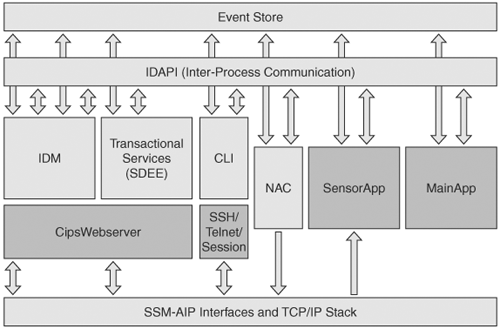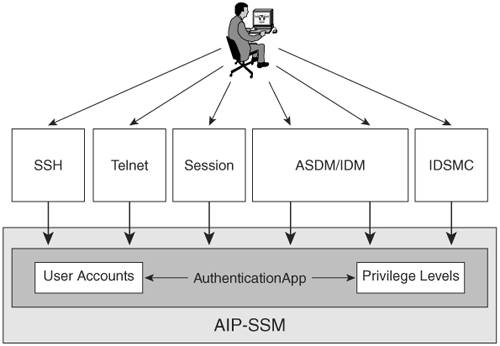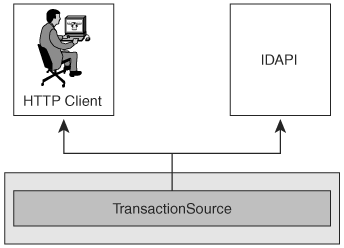Cisco IPS Software Architecture
The Cisco IPS 5.x software was built based on its predecessor, CIDS 4.x. The architecture is similar to the 4.x software, but with several enhancements. This section provides a complete overview of the CIPS 5.x architecture while highlighting some of these differences.
One of the major differences of CIPS 5.x is that it uses the Security Device Event Exchange (SDEE) protocol instead of the Remote Data Exchange Protocol (RDEP) used in versions 4.x. SDEE is a standardized IPS communication protocol developed by Cisco for the IDS Consortium at the International Computer Security Association (ICSA). Remote applications such as Adaptive Security Device Manager (ASDM), IPS Device Manager (IDM), Intrusion Prevention System Management Console (IPSMC) and Cisco Security Monitoring, Analysis and Response System (CS-MARS) can retrieve events from the sensor through this protocol.
Note
ASDM/IDM IPS configuration and troubleshooting is covered in Chapter 19, "Firewall Management Using ASDM."
Cisco IDS Event Viewer (IEV) does not support 5.x events; however, it can still accept 4.x events. SDEE is not backward compatible with RDEP.
Another difference of CIPS 5.x over 4.x is its ability to run IPS operations in inline mode.
The major components of CIPS 5.x software include the following:
- MainApp
- SensorApp
- Network Access Controller (NAC)
- AuthenticationApp
- cipsWebserver
- LogApp
- EventStore
- Transactional Services for Security Device Event Exchange (SDEE)
- CLI
Figure 14-1 illustrates the main components of CIPS 5.x in correlation with the AIP-SSM.
Figure 14-1. CIPS 5.x Architecture Overview

MainApp
MainApp is responsible for several critical tasks in the AIP-SSM (as well as all other platforms that support CIPS 5.x software). These tasks include:
- Initializing all CIPS components and applications
- Scheduling, downloading, and installing software updates
- Configuring communication parameters
- Managing the system clock
- Gathering system statistics and software version information
- Cleanly shutting down/restarting all CIPS services
MainApp is initialized by the CIPS operating system and starts the CIPS applications in the following sequence:
- Reads and validates dynamic and static configurations.
- Synchronizes dynamic configuration data to system files.
- Creates EventStore and the Intrusion Detection Application Programming Interface (IDAPI) shared components.
- Initializes status event subsystem.
- Launches IPS applications as stated in the static configuration.
- Waits until an initialization status event from each application is sent.
- Generates an error event identifying all applications that did not start, if all status events are not received within 60 seconds.
- Listens for control transaction requests and processes them accordingly.
MainApp controls the CIPS software installation and upgrades. It also controls network communication parameters such as:
- AIP-SSM host name
- IP addressing and default gateway configuration for the AIP-SSM command and control interface
- Network access control list
MainApp manages the system clock (whether NTP is configured or not) and collects system statistics.
SensorApp
SensorApp is the application that is responsible for the analysis of network traffic, examining it for any malicious content. The packets flow through it from the Gigabit Ethernet network interface on the AIP-SSM which is directly connected to the Cisco ASA's backplane.
If the Cisco ASA AIP-SSM configuration is set for promiscuous mode, the packets are discarded after processing by SensorApp. If configured for inline operation, the packets will either be forwarded back to the Cisco ASA or dropped according to the defined policy.
SensorApp has two modules crucial for the operation of the AIP-SSM or any other device running CIPS 5.x:
- Analysis Engine Configuration Module (Virtual Sensor)
- Alarm Channel Module (Virtual Alarm)
The Virtual Sensor is the Analysis Engine Configuration Module, which handles the AIP-SSM configuration. This module interprets the configuration and maps it into internal configuration objects. Figure 14-2 illustrates both of these modules.
Figure 14-2. SensorApp Virtual Sensor and Virtual Alarm

In CIPS 5.x, a new protocol is introduced called the Intrusion Detection Configuration (IDCONF) protocol. This framework provides clean, consistent, and accurate signature definitions. This replaces the old IDIOM framework in previous versions. It supports multiple layers of parameters to ensure that a signature is defined in terms that are understandable and valid for the inspection engines. The Virtual Alarm is the alarm channel module, which is responsible for processing all signature events generated by the traffic inspector engine. The primary function of the Alarm Channel Module is to generate alarms for each event as it is passed. Event or alarm filters may be configured and will be processed by the alarm channel module, as illustrated in Figure 14-2.
Network Access Controller
NAC is the application that is responsible for communicating with the Cisco ASA or any other supported device while shunning (blocking) connections if the AIP-SSM is configured in promiscuous mode.
Note
Do not confuse this application with the Cisco Network Admission Control industry-wide initiative sponsored by Cisco to enforce endpoint security policy compliance to mitigate damage from viruses and worms.
One of the functions of CIPS NAC is to forward shunning information to other IPS devices on the network to collectively control network access devices. IPS sensing devices that perform this operation are referred to as master blocking sensors.
AuthenticationApp
AuthenticationApp, as its name suggests, is the process that controls user authentication on the AIP-SSM or any other device running Cisco IPS 5.x software. Additionally, it administers all the user accounts, privileges, Secure Shell (SSH) keys, and digital certificates, while also controlling what authentication method is used.
AuthenticationApp controls authentication when the user connects via Telnet, SSH, a session through ASA, ASDM, IDM, or IDSMC. This is illustrated in Figure 14-3.
Figure 14-3. AuthenticationApp Architecture

cipsWebserver
The CIPS web server (cipsWebserver) within AIP-SSM provides configuration support for IDM and provides support for SDEE transactions such as:
- Reporting security events
- Receiving IDCONF transactions
- Processing IP logs
ASDM is hosted and controlled by the Cisco ASA; however, it launches IDM, which uses SDEE to communicate with the AIP-SSM hosted by the CIPS web server. The CIPS web server supports HTTP 1.0 and 1.1 running Secure Sockets Layer (SSL)/Transport Layer Security (TLS).
LogApp
The AIP-SSM logs alert, error, status, and debug messages as well as IP logs. These messages and IP logs are accessible through the CLI and SDEE clients such as IDM, IDSMC, CiscoWorks Security Monitor, and CS-MARS. LogApp sends log messages with the following five levels of severity:
- Debug
- Timing
- Warning
- Error
- Fatal
These messages are written to the following file on AIP-SSM module:
/usr/cids/idsRoot/log/main.log.
Note
To access this file, you must be logged in with the service account. Instructions on how to create the service account are discussed later in this chapter, in the "User Administration" section. These messages are mostly used by Cisco TAC engineers for troubleshooting purposes.
Example 14-1 shows a sample of the information stored in main.log.
Example 14-1. The main.log File
-bash-2.05b$ more main.log 01Feb2005 20:44:49.643 0.001 cidwebserver[447] Cid/E errTransport WebSession:: sessionTask(10) TLS connection exception: handshake incomplete. 01Feb2005 20:45:09.646 20.003 cidwebserver[4548] tls/W errWarning received fatal alert: certificate_unknown
EventStore
All IPS events are stored in the EventStore with a time stamp and a unique ascending identifier. Additionally, CIPS internal applications write log, status, and error events into the EventStore.
Note
IPS alerts are only written by the SensorApp application.
The EventStore is designed to store CIPS events in a circular fashion. In other words, when it reaches the configured size, the oldest events are overwritten by new events and log messages.
Note
In CIPS 5.x code, the EventStore is reduced to 30 MB from 4 GB in earlier code.
TransactionSource
SDEE and HTTP remote-control transactions are handled by an internal application called TransactionSource. It handles all TLS communications with external management servers and monitoring systems. TransactionSource performs basic authentication to remote management applications and monitoring systems. When an application attempts a remote-control transaction, IDAPI redirects the transaction to TransactionSource, as shown in Figure 14-4.
Figure 14-4. TransactionSource Functionality

Part I: Product Overview
Introduction to Network Security
- Introduction to Network Security
- Firewall Technologies
- Intrusion Detection and Prevention Technologies
- Network-Based Attacks
- Virtual Private Networks
- Summary
Product History
- Product History
- Cisco Firewall Products
- Cisco IDS Products
- Cisco VPN Products
- Cisco ASA All-in-One Solution
- Summary
Hardware Overview
Part II: Firewall Solution
Initial Setup and System Maintenance
- Initial Setup and System Maintenance
- Accessing the Cisco ASA Appliances
- Managing Licenses
- Initial Setup
- IP Version 6
- Setting Up the System Clock
- Configuration Management
- Remote System Management
- System Maintenance
- System Monitoring
- Summary
Network Access Control
- Network Access Control
- Packet Filtering
- Advanced ACL Features
- Content and URL Filtering
- Deployment Scenarios Using ACLs
- Monitoring Network Access Control
- Understanding Address Translation
- DNS Doctoring
- Monitoring Address Translations
- Summary
IP Routing
Authentication, Authorization, and Accounting (AAA)
- Authentication, Authorization, and Accounting (AAA)
- AAA Protocols and Services Supported by Cisco ASA
- Defining an Authentication Server
- Configuring Authentication of Administrative Sessions
- Authenticating Firewall Sessions (Cut-Through Proxy Feature)
- Configuring Authorization
- Configuring Accounting
- Deployment Scenarios
- Troubleshooting AAA
- Summary
Application Inspection
- Application Inspection
- Enabling Application Inspection Using the Modular Policy Framework
- Selective Inspection
- Computer Telephony Interface Quick Buffer Encoding Inspection
- Domain Name System
- Extended Simple Mail Transfer Protocol
- File Transfer Protocol
- General Packet Radio Service Tunneling Protocol
- H.323
- HTTP
- ICMP
- ILS
- MGCP
- NetBIOS
- PPTP
- Sun RPC
- RSH
- RTSP
- SIP
- Skinny
- SNMP
- SQL*Net
- TFTP
- XDMCP
- Deployment Scenarios
- Summary
Security Contexts
- Security Contexts
- Architectural Overview
- Configuration of Security Contexts
- Deployment Scenarios
- Monitoring and Troubleshooting the Security Contexts
- Summary
Transparent Firewalls
- Transparent Firewalls
- Architectural Overview
- Transparent Firewalls and VPNs
- Configuration of Transparent Firewall
- Deployment Scenarios
- Monitoring and Troubleshooting the Transparent Firewall
- Summary
Failover and Redundancy
- Failover and Redundancy
- Architectural Overview
- Failover Configuration
- Deployment Scenarios
- Monitoring and Troubleshooting Failovers
- Summary
Quality of Service
- Quality of Service
- Architectural Overview
- Configuring Quality of Service
- QoS Deployment Scenarios
- Monitoring QoS
- Summary
Part III: Intrusion Prevention System (IPS) Solution
Intrusion Prevention System Integration
- Intrusion Prevention System Integration
- Adaptive Inspection Prevention Security Services Module Overview (AIP-SSM)
- Directing Traffic to the AIP-SSM
- AIP-SSM Module Software Recovery
- Additional IPS Features
- Summary
Configuring and Troubleshooting Cisco IPS Software via CLI
- Configuring and Troubleshooting Cisco IPS Software via CLI
- Cisco IPS Software Architecture
- Introduction to the CIPS 5.x Command-Line Interface
- User Administration
- AIP-SSM Maintenance
- Advanced Features and Configuration
- Summary
Part IV: Virtual Private Network (VPN) Solution
Site-to-Site IPSec VPNs
- Site-to-Site IPSec VPNs
- Preconfiguration Checklist
- Configuration Steps
- Advanced Features
- Optional Commands
- Deployment Scenarios
- Monitoring and Troubleshooting Site-to-Site IPSec VPNs
- Summary
Remote Access VPN
- Remote Access VPN
- Cisco IPSec Remote Access VPN Solution
- Advanced Cisco IPSec VPN Features
- Deployment Scenarios of Cisco IPSec VPN
- Monitoring and Troubleshooting Cisco Remote Access VPN
- Cisco WebVPN Solution
- Advanced WebVPN Features
- Deployment Scenarios of WebVPN
- Monitoring and Troubleshooting WebVPN
- Summary
Public Key Infrastructure (PKI)
- Public Key Infrastructure (PKI)
- Introduction to PKI
- Enrolling the Cisco ASA to a CA Using SCEP
- Manual (Cut-and-Paste) Enrollment
- Configuring CRL Options
- Configuring IPSec Site-to-Site Tunnels Using Certificates
- Configuring the Cisco ASA to Accept Remote-Access VPN Clients Using Certificates
- Troubleshooting PKI
- Summary
Part V: Adaptive Security Device Manager
Introduction to ASDM
- Introduction to ASDM
- Setting Up ASDM
- Initial Setup
- Functional Screens
- Interface Management
- System Clock
- Configuration Management
- Remote System Management
- System Maintenance
- System Monitoring
- Summary
Firewall Management Using ASDM
- Firewall Management Using ASDM
- Access Control Lists
- Address Translation
- Routing Protocols
- AAA
- Application Inspection
- Security Contexts
- Transparent Firewalls
- Failover
- QoS
- Summary
IPS Management Using ASDM
- IPS Management Using ASDM
- Accessing the IPS Device Management Console from ASDM
- Configuring Basic AIP-SSM Settings
- Advanced IPS Configuration and Monitoring Using ASDM
- Summary
VPN Management Using ASDM
- VPN Management Using ASDM
- Site-to-Site VPN Setup Using Preshared Keys
- Site-to-Site VPN Setup Using PKI
- Cisco Remote-Access IPSec VPN Setup
- WebVPN
- VPN Monitoring
- Summary
Case Studies
EAN: 2147483647
Pages: 231
